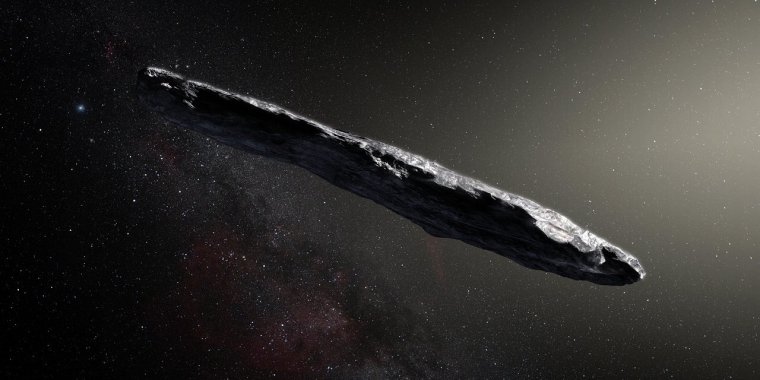| News / Space News |
ESO Observations Show First Interstellar Asteroid is Like Nothing Seen Before
For the first time ever astronomers have studied an asteroid that has entered the Solar System from interstellar space.

Artist’s impression of the interstellar asteroid `Oumuamua. Image credit: ESO (CC BY 4.0)
Observations from ESO’s Very Large Telescope in Chile and other observatories around the world show that this unique object was traveling through space for millions of years before its chance encounter with our star system. It appears to be a dark, reddish, highly-elongated rocky or high-metal-content object.
On 19 October 2017, the Pan-STARRS 1 telescope in Hawai`i picked up a faint point of light moving across the sky. It initially looked like a typical fast-moving small asteroid, but additional observations over the next couple of days allowed its orbit to be computed fairly accurately.
The orbit calculations revealed beyond any doubt that this body did not originate from inside the Solar System, like all other asteroids or comets ever observed, but instead had come from interstellar space.
Although originally classified as a comet, observations from ESO and elsewhere revealed no signs of cometary activity after it passed closest to the Sun in September 2017. The object was reclassified as an interstellar asteroid and named 1I/2017 U1 (`Oumuamua).
The team of astronomers found that `Oumuamua varies dramatically in brightness by a factor of ten as it spins on its axis every 7.3 hours.
This unusually large variation in brightness means that the object is highly elongated: about ten times as long as it is wide, with a complex, convoluted shape. It has a dark red colour, similar to objects in the outer Solar System, and it is completely inert, without the faintest hint of dust around it.
These properties suggest that `Oumuamua is dense, possibly rocky or with high metal content, lacks significant amounts of water or ice, and that its surface is now dark and reddened due to the effects of irradiation from cosmic rays over millions of years. It is estimated to be at least 400 metres long.
Preliminary orbital calculations suggested that the object had come from the approximate direction of the bright star Vega, in the northern constellation of Lyra.
However, even travelling at a breakneck speed of about 95 000 kilometres/hour, it took so long for the interstellar object to make the journey to our Solar System that Vega was not near that position when the asteroid was there about 300 000 years ago.
`Oumuamua may well have been wandering through the Milky Way, unattached to any star system, for hundreds of millions of years before its chance encounter with the Solar System. (ESO)
YOU MAY ALSO LIKE


